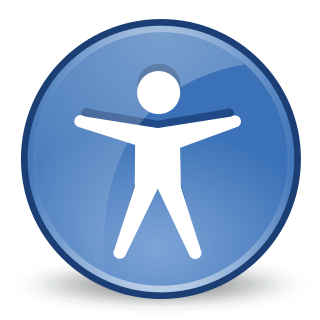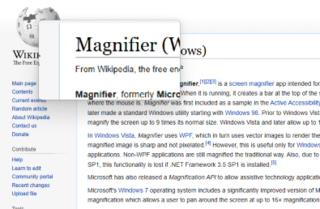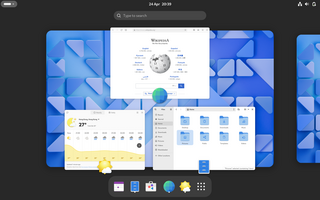Gnopernicus logo | |
 Gnopernicus | |
| Initial release | December 7, 2001 |
|---|---|
| Last release | 1.1.2 / August 21, 2006 |
| Written in | C |
| Operating system | Unix-like |
| Platform | AT-SPI |
| Type | Screen reader Accessibility |
| License | GNU Lesser General Public License 2 |
| Website | wiki |
Gnopernicus was a free GNOME desktop application that provides Assistive Technologies (AT) for blind and visually impaired users. Gnopernicus is not actively developed anymore and has been replaced by Orca in GNOME.

Free software or libre software is computer software distributed under terms that allow users to run the software for any purpose as well as to study, change, and distribute it and any adapted versions. Free software is a matter of liberty, not price: users—individually or in cooperation with computer programmers—are free to do what they want with their copies of a free software regardless of how much is paid to obtain the program. Computer programs are deemed free insofar as they give users ultimate control over the first, thereby allowing them to control what their devices are programmed to do.

GNOME is a free and open-source desktop environment for Unix-like operating systems. GNOME was originally an acronym for GNU Network Object Model Environment, but the acronym was dropped because it no longer reflected the vision of the GNOME project.

Assistive technology is an umbrella term that includes assistive, adaptive, and rehabilitative devices for people with disabilities or elderly population while also including the process used in selecting, locating, and using them. People who have disabilities often have difficulty performing activities of daily living (ADLs) independently, or even with assistance. ADLs are self-care activities that include toileting, mobility (ambulation), eating, bathing, dressing and grooming. Assistive technology can ameliorate the effects of disabilities that limit the ability to perform ADLs. Assistive technology promotes greater independence by enabling people to perform tasks they were formerly unable to accomplish, or had great difficulty accomplishing, by providing enhancements to, or changing methods of interacting with, the technology needed to accomplish such tasks. For example, wheelchairs provide independent mobility for those who cannot walk, while assistive eating devices can enable people who cannot feed themselves to do so. Due to assistive technology, people with disabilities have an opportunity of a more positive and easygoing lifestyle, with an increase in "social participation," "security and control," and a greater chance to "reduce institutional costs without significantly increasing household expenses."
Gnopernicus is a "one-size-fits-all" screen reader that provided speech, Braille, and magnification for users with a range of visual impairments. Gnopernicus provided for user interface customization - including customizing the speech output and voices, customizing the keystroke commands to drive it, customizing the Braille display key input, and customizing the way magnification is rendered. It was also possible to edit the XML files that describe the speech and Braille output renderings. [1]
Gnopernicus was bundled as the default screen reader on GNOME 2.4 on September 10, 2003; [2] however, the development of Gnopernicus was started in 2001. [3] Orca, with its radical different coding approach of making applications accessible, had more flexibility than the original Gnopernicus design and replaced it as the default screen reader in GNOME 2.16 in September 2006. [4] [5]

Orca is a free and open-source, flexible, extensible screen reader from the GNOME project for individuals who are blind or visually impaired. Using various combinations of speech synthesis and braille, Orca helps provide access to applications and toolkits that support the AT-SPI.








